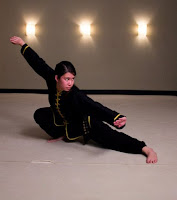More and more we hear about ‘agility’ in project management,
agility leadership, agility in martial arts and canine agility …
Dog’s agility, easiest to explain, is a competitive sport in
which a dog is directed through obstacles in a course that is timed and watched
for accuracy. Easy that one!?
Let’s frame what is ‘agile project management’ - it refers
to iterative and incremental method of managing the design and to build
activities in a project with aim to provide new product or service in a highly flexible
and interactive manner. A bit harder?
 Further, we find that agility training is fundamental to any
(great) martial artist as well. In martial arts it is definitely true that some
genetics play an important role in the development of agility; nevertheless, with
the adequate practice anybody can improve his/her agility. That’s
understandable.
Further, we find that agility training is fundamental to any
(great) martial artist as well. In martial arts it is definitely true that some
genetics play an important role in the development of agility; nevertheless, with
the adequate practice anybody can improve his/her agility. That’s
understandable.
Going even deeper to define agility we meet the use of the
word ‘agility’ in leadership, too. What does it mean? Leadership agility is a
mastery competency needed for sustained success in today’s complex, fast-paced,
business environment. Such a leader has the ability and/or agility to operate
in any manner and to think and react in a number of different ways. Does this
sound more complicated?
Seeing very different connotations and the use of the same
term, let’s pose a question – “How could we suggest a common denominator and
explain it?”
Let’s take some time to discuss how to practice agility in
physical sense?
In martial arts the ideal way to improve previously mentioned
‘effects/attributes’ would be in a fight. But to fight without practice could
be devastating for someone that has no experience and knowledge about it.
Therefore, practice and sparing give the anticipated results in performance, body
and fight techniques, which all ask for better agility. The same goes for the
dogs training in an agility competition. Practice and repetitions!
But how can we practice agility in the same way in project
management or leadership where rather mental than physical ‘effects/attributes’
are needed?
To come with an answer allow me first to describe agility
(agile methods) as a concept.
Agile methodologies are the alternative to ‘waterfall’ – the
traditional sequential development - that helps teams to respond to
unpredictability. ‘Agility’ was introduced in 1970 by Dr. Winston Royce in a
paper Manage the Development of Large Software
Systems in which he criticized sequential development. Agility provides openings
to evaluate the direction of a project throughout the development lifecycle.
The openings are achieved through regular cadences of work, known as sprints or
iterations. It is like today’s event driven programming made for interactive use
of applications where events (initiated by users) drive changes in a (software)
process.
One can easily imagine that a process that is agile is more
likely to be effective than the rigid one. This is specifically true when we do
things that are complex and subject to change. Why? Because the ability to
adapt is necessary for a system not to break down. That is exactly how the nature
works all the time.
But the agility without a well-defined effective process means
only chaos. Therefore, it is very much about the knowledge to discover the
right balance of constrains and flexibility! If a process is to behave as agile
–it needs to embrace a clear ‘understanding’ of where, when and how to change.
Project management and leadership are both processes where a
change may take place on the fly, upon the decision of the performers at the
team level or because of an external interruption – in such cases the principles
of agile methodology are to be applied if a positive result is foreseeable.
Not every team or individual has the wisdom to do the right
thing at the right moment. Because of it we need some kind of constrains that
frame the system’s behavior. Anyhow those constrains should not be too narrow
as we need them to define the limits of processes, but they must add value to
the leadership process and/or the project and not break down the running process.
To summarize the discussion on agility (in leadership and/or
in other fields) we need to support an effective, flexible process that gives
people the ability to adapt to the needs of the current situation and not to
constrain them on what for years we are (were) doing ‘in the same way’. To
achieve that, some means of security (and not insecurity! – see blog: Insecurity
drains the life out of employees http://leadershipbyvirtue.blogspot.com/2015/12/insecurity-drains-life-out-of-employees.html)
have to be built into the system, such means that would allow people to freely
make decisions and also to make (some) mistakes.










yeah before reading this article i was only aware of the agility in project management, may because i am related to IT. but amazed to know that it is active in many departments. Thanks for sharing this. Good day:)
ReplyDeleteThank you for your nice words ....
ReplyDeleteThis comment has been removed by a blog administrator.
ReplyDelete